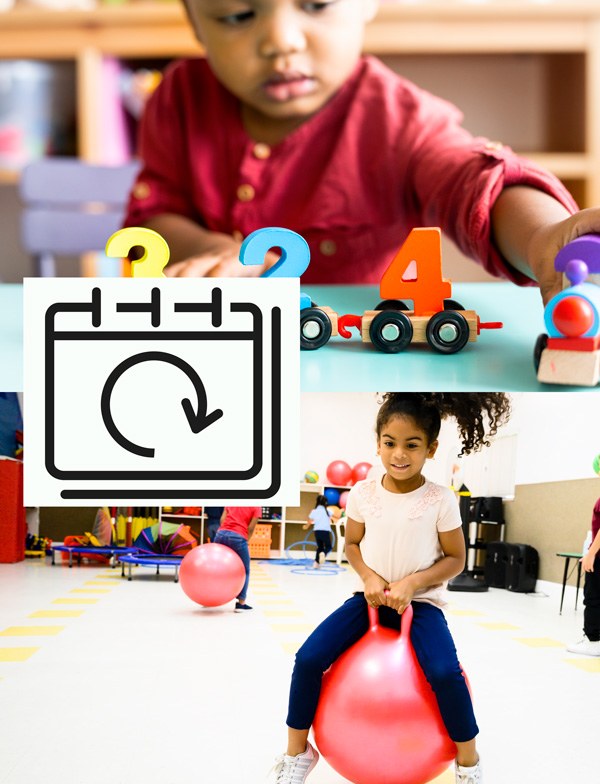Posted: September 18, 2020
Transitioning from one activity to another in the early childhood classroom can be challenging. You may have children who become very upset when having to switch from one activity to another and this can derail your plans for the day.

Balance focused and high-energy activities
Troubles with transitions are usually amplified at the start of the year, given that routines have not been established. Moreover, COVID-19 has likely impacted your typical classroom schedule and program closures may have dramatically altered children's routines, presenting even more challenges than usual. Even in the best of times, transitions can be difficult, but with a little planning and flexibility you can minimize the frustrations that commonly accompany transitions for both yourself and the children in your care.
Why are transitions so hard for some children?
Being able to independently transition from one activity to the next is a key aspect of getting children ready to start kindergarten. However, many young children struggle stopping one activity and moving to another. This can be for a variety of reasons. For children (and adults too!) it can be extremely frustrating having to leave something they are thoroughly engrossed in, especially if they are enjoying what they are doing or feeling that they have nearly completed the activity. Think about your own life. When you are in the middle of a task you may not appreciate being interrupted or pulled away from that task, particularly if it is an unexpected interruption. For other children, transitions can lead to confusion or produce worried feelings. This usually stems from a lack of structure or routine. While some children may be flexible and be able to adapt to interruptions in their routine, others will have difficulty in understanding why they are being asked to do something else, view the situation as unfair, or else feel unsure of what they should do next. Children respond to uncertainty in different ways. When transitions are unexpected or not clearly communicated, this confusion can lead to frustrated outbursts, increased anxiety, and impact how the child goes through the rest of their day.
What you can do to make transitions easier
While transitions can be challenging, there are a number of things that you can do to make moving from one activity to another smoother and minimize disruptions and outbursts. Here are some things to try in your own program:
Set up a schedule.
This is so important. Children tend to handle expected transitions very differently than unexpected ones. Establish a routine and refer to the schedule throughout the day. It can be helpful to start the day with some sort of morning meeting where you will go over what you have planned. Providing reminders about what comes next in the day can be helpful as well, as it would be a lot to ask young children to memorize the schedule. Keep in mind that the child's development, language spoken at home, and language skills can impact  their ability to understand and follow a schedule. Try to incorporate a visual schedule along with a written one. For example, pairing the words "active play" with children playing outside will be more effective than only the written words.
their ability to understand and follow a schedule. Try to incorporate a visual schedule along with a written one. For example, pairing the words "active play" with children playing outside will be more effective than only the written words.
Stick to the schedule but build in transition times.
Following your schedule will provide children a good idea of what to expect and help them develop routines. However, it is okay to be flexible at times. For example, if all children are actively working on an art project and fully engaged, it would probably be a better idea to give them a couple extra minutes to finish up, instead of trying to pull everyone away from the activity. Additionally, remember that transitions take time, even when everything goes smoothly. Building that time into the schedule will allow you to stay on track and not feel rushed or flustered. Think about how long it will take to clean up or get new materials instead of expecting one activity to start immediately after another.
Provide cues that mark the time to transition.
To minimize confusion and surprises in the schedule try to incorporate both verbal and non-verbal cues that signal that it is time, or nearly time, to move to a new activity. For example, providing ten- and five-minute warnings will help make transitions go smoothly. You can also incorporate an instrument or bell to signal that it is time for the next activity. Follow this up with a verbal reminder as well ("do we remember what the bell means?"). Another effective strategy is to incorporate some sort of transition song, like the clean-up song.  Again, when children hear this song, they will have a better idea of what is expected of them and they will likely join in with the song and be more willing to help prepare for the next activity.
Again, when children hear this song, they will have a better idea of what is expected of them and they will likely join in with the song and be more willing to help prepare for the next activity.
Transition in pairs.
For some children who struggle with transitions they may enjoy moving to a new activity with a partner. This can be done proactively by planning partner activities or reactively by asking a child who does not struggle with transitions to help another child get ready. This should be framed in a way that encourages supporting friends in the classroom and not as a punishment for the child that struggles with transitions.
Balance active and calm activities.
You have likely seen times in your classroom where it seems like all the children are getting antsy or fidgety. Physical activity and active play are so important for multiple reasons, including helping children make transitions. Try to remember this when you develop your schedule. If there are multiple indoor, quiet activities planned try to break these up with ones that allow children to run around, get exercise, and be louder than they would in the classroom. Similarly, if you are asking children to transition to an activity like  getting ready to go home, it might be a good idea to provide them with a short, relaxing activity beforehand as opposed to expecting them to go immediately from something extremely active to something focused and calm.
getting ready to go home, it might be a good idea to provide them with a short, relaxing activity beforehand as opposed to expecting them to go immediately from something extremely active to something focused and calm.
Be positive!
Remember that transitions are tough, especially for young children who may not fully understand what you expect of them. Getting frustrated during transitions will only make the situation more challenging for the children in your care. Children will often mirror your own emotions. If you can remain calm and model appropriate behaviors and attitudes during transitions children will pick these up. Also, remember to provide positive reinforcement when you see children transitioning to activities appropriately. Acknowledging desirable behaviors when you see them will only increase their occurrence.
Transitions can be tricky. But with a little preparation and flexibility you can minimize the challenges that often accompany transitions and help prepare the children in your care to be successful in kindergarten and make your life a little easier too.
For more information on transitions strategies in your classroom check out the following Better Kid Care online modules:

